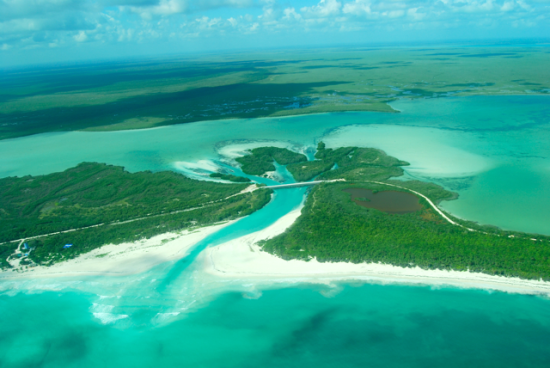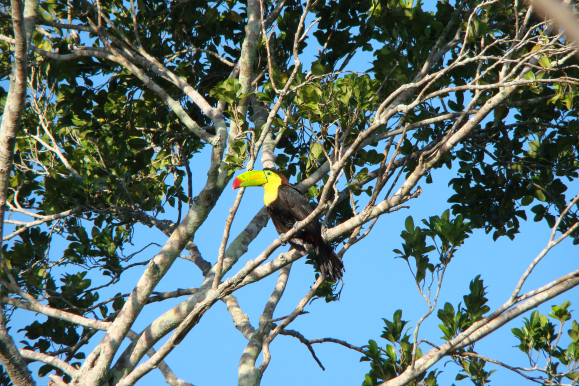Sian Ka’an Biosphere
The bus we catch for the wilderness area known as Sian Ka’an leaves the Cancun terminal at 6 a.m. By Tulum Pueblo the tourist contingent is down to the two of us and an American doctor, who is kicking around Quintana Roo on a two-week vacation.
At 9 a.m. we catch a cab down the beautiful beach along the Boca Paila Road to Ana y Jose‚’s cabanas where our biologist guide, Manuel Galindo, greets us enthusiastically.
‘The Sian Ka’an Biosphere was set aside as a protected natural reserve in January 1986,’ he tells us. From the Mayan, Ziyan Can, meaning ‘birth of the sky,’ the biosphere was the first large-scale attempt by the Mexican government to actively safeguard the fragile ecology in one of Mexico’s last undeveloped areas. The unique reserve covers 1.3 million acres of land, savannas, salt marshes, beaches and three lagoons. The protected area also includes 110 km (69 miles) of coral reef. Less than 1,000 people live in the zone, most of them lobster fishermen in Punta Allen. Manuel drives us to Boca Paila while he tells us about the exceptional flora and fauna of the area – 1,200 species of animals in 17 different classifications.
We join with other tourists for a boat ride into two of the large lagoons. The best part comes when we enter twisting channels lined with reed and mangrove that connect lagoons. The banks are alive with birds – roseate spoonbills, blue and white herons, wood storks, kingfishers, diving cormorants, king vultures – and we’re on the lookout for any of the two species of crocodile, 12 kinds of snake, five types of iguana, wild pheasants, pelicans, flamingoes, jungle cats, manatees, several kinds of marine turtles and Amazonian dolphins that make their home here. Birdwatchers should pick up Barbara MacKinnon’s book, 100 Common Birds of the Yucat n, published by Amigos de Sian Ka’an. Helpful descriptions and even more helpful color photos aid in identification.
After seeing some ojos de aqua in the lake, we re-enter the canal and dock at an overgrown Maya ruin, a customs house that checked cargo and collected fees from trading canoes nearly 1,000 years ago. The highlight of the trip occurs when Manuel goes ahead in the boat while we jump in the strong current of the channel and float downstream, joking about the two types of crocodiles. Trips into the Biosphere run daily, and are sponsored by the Amigos de Sian Ka’an, a private non- profit environmental group that works closely with the government to promote sustainable resource management in the zone. To insure the lowest possible impact, usually no more than 18 visitors per day are allowed in the preserve.
Our second venture into the wilderness comes on a Thursday night when we take a cab from Tulum Pueblo to the Muyil ruins to meet Carlos, a working biologist. We pile into a launch with several Austrian tourists and set out into the black lagoon, led only by the glare from Carlos’ coal miner’s helmet and the light of a billion stars. The lagoon’s water is warm and shallow, ideal territory for the prehistoric nocturnal-hunting crocodile. Carlos explains the counting and tagging research is to ascertain if the crocodile population can be sustained with selective harvesting by the local Maya families. If it can – and they can make money at it – it will take some of the ecological pressure off other resources and lessen the need for slash and burn agriculture. When Carlos sees the tell-tale red dots of a croc’s eyes, he turns on a car-battery-powered spotlight that eerily illuminates the mangrove trees along the bank. The crocodiles slide back farther into the tangled web of roots; it’s a little too cool this evening to lure them out. We miss out on the thrashing and rolling of the beasts along the boat as they’re marked with metal tags. It will be for someone else, another week. Meanwhile the southern sky puts on a show of twinkly lights and shooting stars that boggles the senses, while little fish jump in front of Carlos’ light in a dance of silver and shine. We lay back in the boat, hands dangling in the warm water and pretend we’re Maya traders, slicing across the trackless world of the night lagoon. Never to be forgotten.


